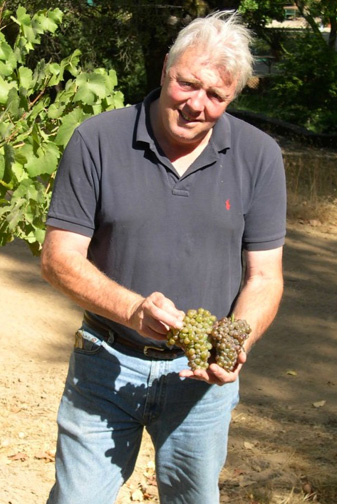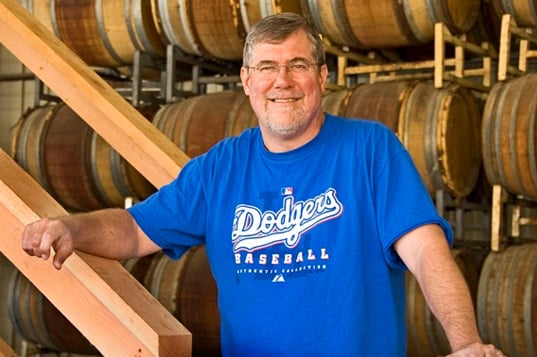The bubble economy that burst in 2008 was inflated in more ways than housing prices. It had also seemed to push New World wines to ever increasing levels of ripeness and power. There’s a generation of California winemakers coming of age in the wake of those boom years looking to fashion a more drinkable style of wine. Some of them have joined forces in the Pursuit of Balance, a group that recently held tastings in San Francisco and New York.
There are also established producers in California who ignored fashion, quietly pursuing a consistent style of drinkable, ageworthy wine for thirty or sixty years, as witnessed by two tastings that happened to fall on the same day in May.
Peter McCrea and his daughter, Sarah, showed a range of chardonnays and rieslings back to 1973, to celebrate the 60th anniversary of Stony Hill Vineyards at Corkbuzz. Their 1973 Chardonnay is a vibrant, mountain-grown wine, floral, spicy, fragrant with lemon curd flavors. It was winemaker Mike Chelini’s first vintage at Stony Hill, the year he came on to assist Peter’s father, Fred, the man who established the style Chelini continues to this day—dry-farmed vines on a northeast-facing slope of Spring Mountain, picked at 23.5 Brix “generally speaking,” made without malolactic fermentation and aged in neutral oak barrels.


“My parents went there and cut the budwood at Livermore,” Peter McCrea says. “They didn’t know anything about growing grapes. The original vineyard was about as classic a Wente clone as you’ll ever find: some vines had no grapes, some had hens and chicks, some a great big crop. As time went on, we developed our own selection. In 1956, Louis Martini, Jr., had just gotten out of Davis; he came up and did a rigorous clonal selection for Stanly Ranch [in Carneros] and he gave us a great pool of budwood.”
Later, they experimented with Clone 4, which McCrea traces back to Stony Hill via Stanly Ranch and heat treatment at Davis—to remove virus. “We planted an acre in our vineyard,” he says, “and it was totally different. The wine had a tropical fruit taste to it.”
Both McCrea and Chelini acknowledge that selling the wine through a mailing list from early on has helped them—or forced them—to maintain the style Fred McCrea established. Chelini recalled that one year, when he broke in some new barrels with chardonnay that he later incorporated into the blend, he got a call from a customer who asked what he’d done, concerned that he was changing the style. He didn’t try it again. “We have 2,000 people who want this style of wine. You just don’t walk away from your customers.”
“This is an enormously unforgiving style of chardonnay,” McCrea says. “There’s nothing to hide your flaws. You have to have great grapes to make this style of wine.”
McCrea’s philosophy echoed Bob Lindquist’s words earlier the same day at The Dutch, where he had presented Qupé’s 30th anniversary tasting. Lindquist’s own pursuit of balanced wine has been focused on syrah and its siblings from the Rhône.
Lindquist got his start working with Jim Clendenen at Zaca Mesa, before establishing Qupé in 1982. At the time, syrah plantings in California were limited and Paso Robles was his source, but he began to look for cooler sites where the grapes would hold their acidity. Bob Miller of Bien Nacido Vineyards offered to graft some vines over to syrah, and while Lindquist feared the site was, perhaps, too cold, they settled on a block in the warmest part of the vineyard, planted to riesling on its own roots in 1973, grafted to syrah in 1986.


Lindquist says he picked up a few clues about ripeness when Gerard Chave came to visit in 1995; he asked about the tendency for syrah grapes to dimple as they ripen: “‘The day you think it’s the perfect day to pick syrah,’ Chave told me, ‘pick it the day before.’”
His 1996 Bien Nacido Hillside is juicy and vibrant; his ’99 lasting with strawberry spice and iron-red tannins. The 2001, a tightly focused, floral beauty, was my favorite of the older wines; Lindquist held back some stock of the ’01 and it is just now in re-release.
Lindquist believes that syrah should be elegant. “It shouldn’t be about power or jamminess,” he says. And though he’s more likely to don a Dodger’s t-shirt than a new-age caveman robe, that quest for elegant, balanced syrah has led him to biodynamic farming.
“When we planted Sawyer Lindquist,” he says of the vineyard project in Edna Valley he began in 2005, “we were on the fence between farming organically or biodynamically.” He happened to meet up with Dominique Lafon and Andre Ostertag in London, and they convinced him over dinner to treat the soil with biodynamic preparations before planting. “Young vines are getting their input from the topsoil,” he says, believing those preparations helped the vines settle in.
Sonnie’s Syrah is his best selection from the vineyard, which he blends from some of the lightest barrels. When I tasted the 2009, it had the cracked black pepper spice and delicate nuances that I crave in syrah. It’s a bottle I would pack, along with the 1994 Stony Hill Chardonnay, to take to Europe and show what the New World can do in pursuit of balance.
This is a W&S web exclusive feature.
Joshua Greene is the editor and publisher of Wine & Spirits magazine.
This is a W&S web exclusive. Get access to all of our feature stories by signing up today.
















